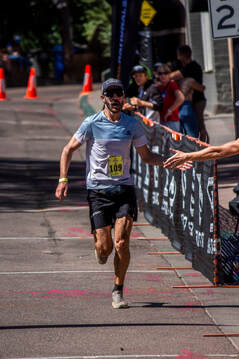Sean Rimmer, Physical Therapist & Running Coach at Run Potential Rehab & Performance in Colorado Springs, CO “Regain your confidence to run pain free & to your potential”  photo credit - Peter Maksimow photo credit - Peter Maksimow It’s finally August, and the Pikes Peak Marathon & Ascent weekend is just around the corner. If you’ve been honest with your training, your confidence should be building. At this point, your training environment and focused runs (ie. long runs & workouts) should aim to be as specific as possible for the final month of training; as you only have a few more weeks to peak your training before you begin your taper. So what might that training schedule look like? Well to start, if you’ve followed some of the training build up from Part 1 & 2 of this training blog series, your training may look like the following:
With about 5-weeks left of total training, I recommend the following general guideline. The next 3-weeks will be your final building weeks followed by a 10-14 day taper period. For the 3 weeks of training build, I recommend the following:
Throughout the rest of this article, I will highlight the quality long run, the running workouts, the taper period, and final tips for race day.  photo credit - Jack Hulett photo credit - Jack Hulett Quality Long Runs The long run should now be the staple effort in preparation for race day for a multitude of reasons. Our long run should be relatively specific in duration to race day, it can include steady-state quality efforts, race day specific practice (ie. run/hike combo), as well as race day nutrition and wearable prep. Think of your long runs now being similar to a “dress rehearsal” for race day. I recommend your long runs being up to 3-5 hours for the Ascent, and 4-7 hours for the marathon. The duration will be based on your expected time, but doesn’t have to be exact. The goal is to allow your body to become conditioned to locomoting for that amount of time in a relatively specific manner for race day. I recommend trying to get a minimum of 4-5 thousand feet of vertical gain for your final few long runs for both the ascent and marathon. If you live in the mountains, this shouldn’t be too difficult to manage. But, if you live in a flatter geographical area, my recommendations are as follows: Use a tread-mill at 8-11% grade or find a smaller hill/bridge and do lots and lots of uphill repeats. Now, the other piece to discuss here is the altitude and most specifically above tree-line (~12 thousand feet in CO). If you live in an area with accessibility to high altitude, I highly recommend doing some of your long run efforts above tree-line. For example, for CO locals that could mean doing a longer 14-er (14 thousand ft peak in CO) which includes uphill running/hiking and downhill running/hiking, or driving up to the summit of Pikes Peak then running down to Barr Camp then running/hiking up at a given effort. So where does the “quality” piece come to play in the long run? By utilizing a workout during or throughout your long run. I recommend a steady-state effort this late in the training to be most specific for race day, as the higher intensity workouts will likely not be as specific to your race effort. An example could look like the following:
The overall time duration here is ~3.5 hours with 90 minutes of quality broken up into 3 parts. You can get somewhat creative with this, as long as the duration and environment are as specific as possible to race day. The last piece to work on during your long runs is your race day nutrition and wearables. I recommend dialing what works best for you to wear (ie. shirt, shorts, running vest, hand-helds, belt, etc.) and practicing how you may take your calories (ie. gels, liquids, real food, etc). The more you dial this prior to race day, the more confident you will feel mentally, physically, and potentially reducing the risk of gastro-intestinal issues.  photo credit - Peter Maksimow photo credit - Peter Maksimow Steady-State Workouts The stand alone steady-state workouts should be incorporated 1-2x a week for the final few weeks, not including your quality long run. These workouts will be somewhat similar to your long run efforts, but for a shorter total duration. Just to review, these efforts should be of a moderate intensity or consider this an intensity that’s just slightly uncomfortable. Here are a few examples that you may incorporate this late in training:
Again, you can be creative with the varying time domains, but for the individual steady-state workouts I recommend doing at the longest a 90 min steady-state continuous effort and at the shortest 20 min. It’s really all about the total time at the intensity. If you’re doing the marathon, I recommend doing 1-2 steady-state efforts (for at least a portion of the workout) on a downhill grade similar to barr-trail. Though the downhill will not be as challenging on the cardio-respiratory system, it will take a larger toll on your musculoskeletal system. Therefore, it will benefit you come race day if you’ve prepped your legs to handle some longer downhill at a slightly more intense effort than an easy run.  photo credit - Peter Maksimow photo credit - Peter Maksimow Taper Period The taper period is not complete rest before race day, but rather a reduction in total volume and intensity of your training. I recommend anywhere between 14-10 days of taper for this race especially if your final 3-weeks building up in August had the appropriate amount of volume and intensity. Choosing how to taper can be challenging if you’re unsure on what to do. I recommend the 1st half of taper (~5-7 days) to reduce volume and intensity by 50% from the previous week, and the second half of your taper to be 25% of your last training week. For example, if your long run was 4 hours, your final two long runs will be 2 hours, then 1 hour, respectively; and for your steady-state run, if you were doing 3x30 mins, it can now be 2x15 min, and then 1x15 min, respectively. This will allow you to recover, but still sharpen your fitness to not feel sluggish on race day. The ultimate goal is to feel fresh, excited, healthy, and fit on race day! Final Race Day Tips Finally, here are my top tips for race day based on my race experience on the course:
Closing Thoughts You’ve come a long way since you’ve signed up for the Pikes Peak Marathon or Ascent! Hopefully, you’ve taken some principles and recommendations from this 3-Part series into your own training whether it’s your first or tenth Pikes Peak Marathon or Ascent. If you’ve taken your training seriously over the past 3-4 months, you will be ready, and if not, that’s okay too, you can still give your best on the day. When it gets tough out there, just remember this event is something we choose to do, it’s hard for everyone pushing themselves out there, but the reward of finishing is something no one can ever take away from you! Written by: Sean Rimmer, Physical Therapist & Running Coach at Run Potential Rehab & Performance in Colorado Springs, CO. “ Regain your confidence to run pain free & to your potential” Comments are closed.
|
©
Pikes Peak Marathon


